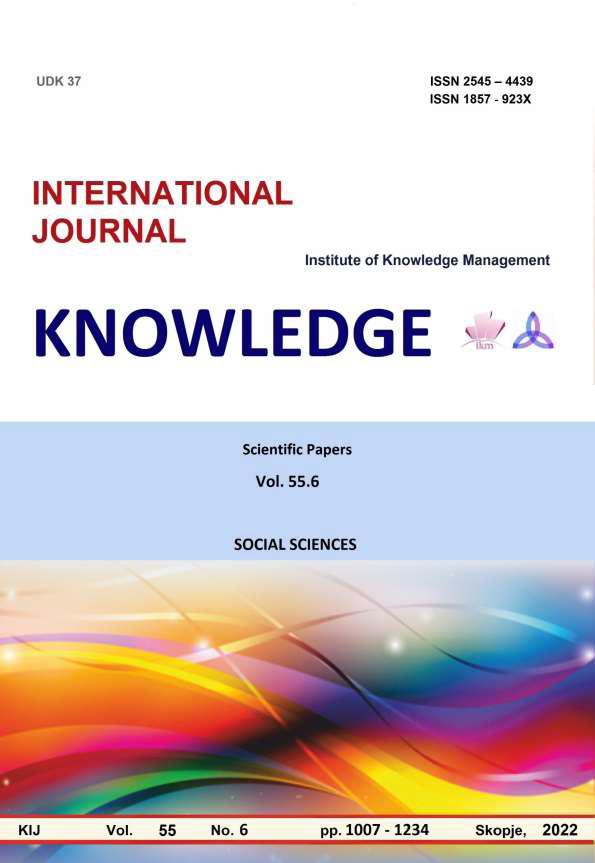INSTITUTIONAL DEVELOPMENT AND ECONOMIC GROWTH OF EUROPEAN TRANSITION COUNTRIES
Keywords:
institutional development, economic growth, transition countries, EUAbstract
Institutions in a broader sense represent the adopted norms and rules of behavior in society. They define
the necessary constraints that a society has adopted in order to shape and direct human interactions. Institutional
change is a positive targeted adjustment of these constraints in line with social development. Due to the existence of
a synergistic effect, any institutional change can cause significant social and economic changes.
The goal of the European transition countries to join the EU is at the same time a strong driver of their needful
institutional transformation and necessary institutional harmonization with the EU countries. This strategic goal,
which originally stems from social consensus, has a strong capacity to promote, consolidate and implement the
necessary reform processes. Harmonization of institutions and, consequently, full membership in the EU generates a
safer and more predictable social (and thus economic) environment. Strong institutions do not tolerate a large sphere
of discretionary decision-making, creating a basic precondition for increasing domestic and foreign investments.
However, the institutions also fundamentally depend on the cultural heritage of transition countries, which cannot be
compensated and balanced so quickly with the traditional market economies of the EU. Institutions are a complex
category whose description is not simple. Respect for democratic principles of functioning of public institutions is
especially important for the presence and level of corrupt social activity. It is generally accepted that corruption, as
abuse of authority in order to gain illicit benefits, is a serious obstacle to social and economic advancement,
significantly reducing the possibility of successful implementation of state measures and decisions. Institutions
reduce uncertainty and increase the predictability of decisions of all actors in the economic life of the country.
The eight transition European economies that were leaders in institutional development dynamics and became the
EU members in 2003 had a GDP of $ 36,855 pc at the end of 2018, which is an absolute increase of $ 28,165. Three
European countries in transition that last became the EU members, together with five countries of the Western
Balkan as countries with relatively undeveloped institutions, in 2018 had an average GDP per capita of current
international $ 22,114 compared to 4,092 in 1990. In addition, GDP pc by five-year periods data show that the
leading countries of institutional development were far less affected by the 2009-2010 crisis. We should always keep
in mind the fact that these countries’ institutional convergence towards the developed market economies institutions
must not be an aim in itself, but a way to achieve better business conditions and ultimately more dynamic and
quality economic growth and development.
A review of numerous studies confirmed the fact that institutions have a strong influence on economic performance.
References
Acemoglu, D. & Robinson, J. (2019). The Narrow Corridor. States, Societies and the Fate of Liberty. London: Penguin Random House.
Alonso, J., Garcimartin, C., & Kvedaras, V. (2020). Determinants of institutional quality: an empirical exploration, Journal of Economic Policy Reform, 23 (2), 229-247. https://doi.org/10.1080/17487870.2020.1719102
Dequech, D. (2004). Uncertainty: individuals, institutions and technology. Cambridge Journal of Economics, 28(3), 365-378. https://doi.org/10.1093/cje/28.3.365
Haggard, S., & Tiede, L. (2011). The rule of law and economic growth: where are we? World Development, 39(5), 673-685. https://doi.org/10.1016/j.worlddev.2010.10.007
Hodgson, G. (2006). What Are Institutions? Journal of Economic Issues, Vol. XL No. 1, pp. 1-25. https://doi.org/10.1080/00213624.2006.11506879
Nawaz, S., Iqbal, N., & Khan, M. A. (2014). The impact of institutional quality on economic growth: panel evidence. The Pakistan Development Review, 15-31. https://doi.org/10.30541/v53i1pp.15-31
Petrova, B. (2021). Redistribution and the Quality of Government: Evidence from Central and Eastern Europe. British Journal of Political Science, 51(1), 374-393. https://doi.org/10.1017/S0007123419000085
Pérez-Moreno, S., Bárcena-Martín, E., & Ritzen, J. (2020) Institutional quality in the Euro area countries: any evidence of convergence?,Journal of Contemporary European Studies, 28(3), 387-402. https://doi.org/10.1080/14782804.2020.1779044
Siddiqui, D. A., & Ahmed, Q. M. (2009). The Causal Relationship between Institutions and Economic Growth: An Empirical Investigation for Pakistan Economy, Munich Personal RePEc Archive Paper No. 19745, posted 8, http://mpra.ub.uni -muenchen.de/19745.
World Bank. (2022). Worldwide governance indicators. DataBank. Retrieved May 8, 2022, from https://databank.worldbank.org/source/worldwide-governance-indicators.





